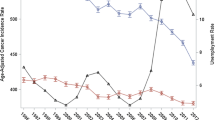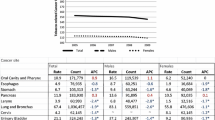Abstract
Objective: Data from the 11s Surveillance, Epidemiology, and End Results tumor registries cover 14% of the US population and are often used to provide national estimates of cancer incidence and survival. Cancer mortality data for the US and for SEER are compared to assess the representation of SEER to the US.
Methods: Comparisons between US and SEER cancer mortality were made for 16 of the leading causes of cancer death. Cancer site-specific comparisons were also made by race and sex. In addition, tobacco-related cancers were considered. Analyses were performed for the years when all 11 SEER registries were included in the SEER program. Poisson regression was used to estimate site-specific cancer mortality rate ratios between the US and SEER.
Results: Cancer site-specific mortality rates derived from SEER data tend to under-represent the US cancer mortality experience for white males and females and black males. Under-representation is observed across the majority of SEER registries, with the highest amount of under representation in Utah and New Mexico. Under-representation of SEER data compared with US data is noticeably greater among tobacco-related cancers, particularly in Utah and New Mexico.
Conclusion: For certain cancer sites, particularly tobacco-related cancers, the SEER coverage population is not representative of the US population.
Similar content being viewed by others
References
Jemal A, Tiwari RC, Murray T, Ghafoor A, Samuels A, Ward E, Feuer EJ, Thun MJ (2004) Cancer statistics, 2004. CA Cancer J Clin 54: 8–29.
National Center for Health Statistics. Mortality Data from the National Vital Statistics System. Available at: http://www.cdc.gov/ nchs/about/major/dvs/desc.htm.
Merrill RM, Capocaccia R, Feuer EJ, Mariotto A (2000) Cancer prevalence estimates based on tumour registry data in the surveillance, epidemiology, and end results (SEER)program. Int J Epidemiol 29: 197–207.
Ries LAG, Eisner MP, Kosary CL, Hankey BF, Miller BA, Clegg L, Mariotto A, Fay MP, Feuer EJ, Edwards BK eds. (2003) SEER Cancer Statistics Review, 1975–2000, National Cancer Institute. Bethesda, MD;Available at: http://seer.cancer.gov/csr/ 1975_2000, 2003.
National Program of Cancer Registries, Cancer Prevention and Control, Centers for Disease Prevention and Control, 2004. Available at: http://www.cdc.gov/cancer/npcr/.
Ries LA, Wingo PA, Miller DS, Howe HL, Weir HK, Rosenberg HM, Vernon SW, Cronin K, Edwards BK (2000) The annual report to the nation on the status of cancer, 1973–1997, with a special section on colorectal cancer. Cancer 15: 398–424.
Howe HL, Wingo PA, Thun MJ, Ries LA, Rosenberg HM, Feigal EG, Edwards BK (2001) Annual report to the nation on the status of cancer (1973–1998), featuring cancers with recent increasing trends. J Natl Cancer Inst 93: 824–842.
Weir HK, Thun MJ, Hankey BF, Ries LA, Howe HL, Wingo PA, Jemal A, Ward E, Anderson RN, Edwards BK (2003) Annual report to the nation on the status of cancer, 1975–2000, featuring the uses of surveillance data for cancer prevention and control. J Natl Cancer Inst 95: 1276–1299.
US Cancer Statistics Working Group. United States Cancer Statistics:1999 Incidence. Atlanta (GA): Department of Health and Human Services, Centers for Disease Control and Prevention and National Cancer Institute;2002.
US Cancer Statistics Working Group. United States Cancer Statistics:2000 Incidence. Atlanta (GA): Department of Health and Human Services, Centers for Disease Control and Prevention and National Cancer Institute;2003.
Wingo PA, Jamison PM, Hiatt RA, Weir HK, Gargiullo PM, Hutton M et al. (2003) Building the infrastructure for nationwide cancer surveillance and control-a comparison between the national program of cancer registries (NPCR)and the surveillance, epidemiology, and end results (SEER)program (United States). Cancer Causes Contr 14: 175–193.
Frey CM, McMillen MM, Cowan CD, Horm JW, Kessler LG (1992) Representativeness of the surveillance, epidemiology, and end results program data:recent trends in cancer epidemiology. J Natl Cancer Inst 84: 872–877.
Dorn HF (1994) Illness from cancer in the United States. Public Health Rep 59: 33–48, 65–77, 97–115.
Dorn HF, Culter SJ (1959) Morbidity from cancer in the United States. Public Health Serv Monogr 56: 1–207.
Cutler SJ, Young JL Jr, eds. (1975) Third national cancer survey: incidence data. Natl Cancer Inst Monogr 41: 1–454.
Cutler SJ, Ederer F, eds. (1961) End results and mortality trends in cancer:part 1. End results in cancer. Natl Cancer Inst Monogr 6: 1–129.
SEER. Characteristics of the SEER population compared with the total United State population. National Cancer Institute. Avail-able at: http://www.seer.cancer.gov/registries/characteristics.html.
Percy C, Van Holten V, Muir C, eds. (1990) International Classification of Diseases for Oncology, 2nd edn. Geneva: World Health Organization.
US Public Health Service (1968) International Classification of Diseases, 8th Revision, adapted for use in the United States by the US Department of Health, Education and Welfare Public Health Service. Washington DC: Author.
American Medical Association (1997) International Classification of Diseases, 9th Revision, Clinical Modification, 3rd edn, Vols 1–2. Dover, DE: Author.
World Health Organization (1992) International Statistical Clas-sification of Diseases and Related Health Problems:ICD 10. Vols 1–3. Geneva: Author.
Shambaugh EM, Weiss MA, Axtell LM (1981) Summary Staging Guide for the Cancer Surveillance, Epidemiology, and End Results (SEER)Program. US Department of Health and Human Services. Public Health Service. National Institutes of Health. NIH Publication No. 81–2313.
United States Department of Health and Human Services, Reducing the Health Consequences of Smoking:25 Years of Progress. A Report of the Surgeon General, 1989, DHHS Publication No. (CDC)89–8411 (Rockville, Md.: Centers for Disease Control, Office on Smoking and Health, 1989).
SEER*Stat 5.1, Released January (2004) National Cancer Insti-tute. Available at http://seer.cancer.gov/seerstat/.
SEER*Stat Database:Mortality-All COD, Public-Use With State, Total US (1969–2000), National Cancer Institute, DCCPS, Surveillance Research Program, Cancer Statistics Branch, released April 2003. Underlying mortality data provided by NCHS (www.cdc.gov/nchs).
Surveillance, Epidemiology, and End Results (SEER)Program (www.seer.cancer.gov)SEER*Stat Database:Populations-Total US (1969–2000), National Cancer Institute, DCCPS, Surveillance Research Program, Cancer Statistics Branch, released April 2003.
McCullagh P, Nelder JA (1989) Generalized Linear Models, 2nd edn. London: Chapman Hall.
Merrill RM, Hilton SC, Daniels M (2003) Impact of the LDS church 's health doctrine on deaths from diseases and conditions associated with cigarette smoking. Ann Epidemiol 13: 704–711.
Tobacco use-2002. Prevalence data. Behavior risk factor surveil-lance system. National Center for chronic Disease Prevention and Health Promotion. Available at http://apps.nccd.cdc.gov/brfss/ list.asp?cat=TU&yr=2002& qkey=621&state=All.
Health, United States, 2003. Table 60. p. 214. Available at http:// www.cdc.gov/nchs/products/pubs/pubd/hus/trendtables.htm.
Merrill RM (2001) Demographics and health-related factors of men receiving prostate-specific antigen screening in Utah. Prev Med 33: 646–652.
Lemon S, Zapka J, Puleo E, Luckmann R, Chasan-Taber L (2001) Colorectal cancer screening participation:comparisons with mammography and prostate-specific antigen screening. Am J Public Health 91: 1264–1272.
Hofer T, Katz S (1996) Healthy behaviors among women in the United States and Ontario:the effect on use of preventive care. Am J Public Health 86: 1755–1759.
Kiefe C, Williams O, Greenlund K, Ulene V, Gardin J, Raczynski J (1998) Health care access and seven-year change in cigarette smoking. The CARDIA Study. Am J Prev Med 15: 146–154.
Hambright TZ (1969) Comparability of marital status, race, nativity, and country of origin on the death certificate and matching census record. Vital Health Stat 2: 1–47.
Sorlie PD, Rogot E, Johnson NJ (1992) Validity of demographic characteristics on the death certificate. Epidemiology 3: 181–184.
Poe GS, Powell-Griner E, McLaughlin JK, Placek PJ, Thompson GB, Robinson K (1993) Comparability of the death certificate and the 1986 National Mortality Followback Survey. Vital Health Stat 2 (118):1–53. DHHS Publ. No. (PHS)94–1392.
Kircher T, Nelson J, Burdo H (1985) The autopsy as a measure of accuracy of the death certificate. N Engl J Med 313: 1263–1269.
Percy C, Stanek E 3rd, Gloeckler L (1981) Accuracy of cancer death certificates and its effect on cancer mortality statistics. Am J Public Health 71: 242–50.
Percy CL, Miller BA, Gloeckler Ries LA (1990) Effect of changes in cancer Classification and the certificates on trends in cancer mortality. Ann NY Acad Sci 609: 87–99.
Rights and permissions
About this article
Cite this article
Merrill, R.M., Dearden, K.A. How representative are the surveillance, epidemiology, and end results (SEER) Program cancer data of the United States?. Cancer Causes Control 15, 1027–1034 (2004). https://doi.org/10.1007/s10552-004-1324-5
Issue Date:
DOI: https://doi.org/10.1007/s10552-004-1324-5




